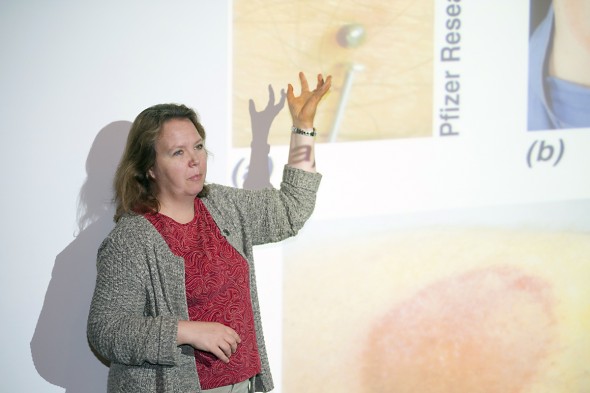Solving problems that aren’t on a multiple-choice test

Despite large class sizes, “I don’t want anyone lost in the rafters,” says biology lecturer Sandra Gibbons. Photo: Roberta Dupuis-Devlin/UIC Photo Services
2013 Silver Circle Award
Since 1966, the Silver Circle has been presented to some of UIC’s best teachers. What makes the award especially meaningful is its selection committee: the graduating seniors.
Sandra Gibbons
Visiting lecturer in biological sciences
College of Liberal Arts & Sciences
Sandra Gibbons’ three UIC microbiology classes average 150 students each. Still, she gets to know her students, giving them a chance to ask questions and “really engage.”
“Engaged” is a word Gibbons uses often.
“I don’t want anyone lost in the rafters,” she says.
Although she’s been teaching for 20 years — since 1992 at Moraine Valley Community College and at UIC since 2004 — Gibbons frequently redesigns her course.
Because today’s students are visual learners, she says, she includes pictures, web videos and animations to help them understand biological concepts.
This semester she added a service learning assignment to her classes.
Most of her students are pre-health, headed for careers in nursing, medicine, pharmacy and similar fields.
“They always seem most engaged when we are talking about a real-life situation,” she says.
Gibbons hates to think that there are diseases that could be controlled but aren’t because of lack of funding. So she built her four-part service-learning assignment around the correlation between child mortality and lack of access to clean drinking water or hygiene.
First she asked her students to write a blog as they researched child mortality and disease. Because UIC is a global campus, some students had personal experience or family members who live in countries where lack of clean drinking water is a real and immediate problem.
Next the students were assigned a pathogen and asked to write a public health brochure about the dangers. She told them, “Don’t use any fancy biological terms to try to impress me.”
The results were “fantastic. The marketing department should hire my students,” Gibbons says.
For the service part, her students are collecting soap for Clean the World, a nonprofit that distributes soap and hygiene packets to areas beset by diseases like cholera, as well as to the homeless in this country.
So far the students have collected more than 1,000 bars of soap.
Finally, they will write a reflection paper on their experience.
“I think this is something they will remember,” Gibbons says.
“Our students are going to have to fix the messes we’ve made,” she adds. “They are going to have to solve problems that are require more than just doing well on a multiple choice test, and it’s my goal to teach them how to do that.”
